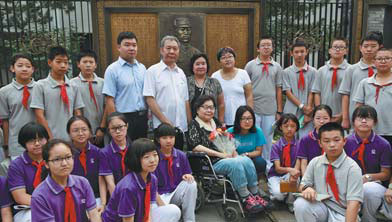Beijing devotes artworks to two wartime leaders
A copper statue and a group of relief sculptures in memory of two Chinese generals who died during the War of Resistance against Japanese Aggression (1937-45) were unveiled on July 6 in Beijing's Xicheng district.
Tong Lin'ge and Zhao Dengyu died in the battle around Nanyuan, a suburb of Beijing, on July 28, 1937. The new artworks were installed on two roads that bear their names.
The event, sponsored by the city government of Beijing, is part of a series of activities marking the 70th anniversary of victory in both the War of Resistance against Japanese Aggression and the global war against fascism.
Tong, who died at 45, was the first high-ranking senior Chinese military officer to die in the war. Zhao was 39.
The copper statue in memory of Tong depicts a broken pocket watch. It is nearly 2 meters high and the watch's hands are fixed at the tragic moment Tong died. The watch is linked to a chain of 77 rings, which refer to the date when the Japanese Imperial Army began its invasion of North China on July 7, 1937, with the Marco Polo Bridge Incident.
Atop of the statue sits two kylins, in Chinese art a mythical animal of composite form. In Mandarin, copper has the same pronunciation as Tong, and kylins is pronounced "lin".
The relief sculpture in memory of Zhao Dengyu was installed on a wall of Beijing No 35 High School on Zhao Dengyu Road. The sculpture tells of Zhao's life and his heroic resistance against Japanese invaders.
Beside the sculpture is introduction of the Lugouqiao Bridge Incident, or Marco Polo Bridge Incident, as it is known in the West. On the right is an exhibition of Zhao's calligraphy.
The two generals served under Feng Yuxiang (1882-1948), a warlord in North China famous for his anti-Japanese sentiment. Many of Feng's former officers fought with distinction in the war.
In 1933, Zhao received a promotion to commander of the 132nd division in the 29th Army because of his bravery and skill during the defense of the Great Wall, in which he and his soldiers killed over 100 enemy troops and destroyed 18 enemy artillery units.
Tong was named deputy commander of 29th Army, garrisoning Beijing and Tianjin, in 1936. The headquarters of the 29th Army were located in Nanyuan.
On July 25, 1937, the Japanese army launched an attack around Beijing and Tianjin. On the morning of July 28, Japanese troops attacked Nanyuan with the support of dozens of fighter planes. Tong defended and fought back invaders while Zhao led an advance regiment to support the frontline.
According to historians, they led the troops stationed in Nanyuan to resist the Japanese troops to the last minute of their lives.
Beijing was a focus for both sides in the war against Japan because of its strategic location connecting the northeast of China and North China. Local residents and armies' persevering resistance against the occupying Japanese Imperial Army kept the city from falling into the hands of Japan during World War II.
Many historians say Tong and Zhao represent two unyielding heroes fighting against Japanese invaders in Beijing.
The Kuomintang government posthumously conferred upon both the rank of army general on July 31, 1937. Former Chinese leader Mao Zedong spoke highly of them as the "greatest models for all Chinese".
duxiaoying1@chinadaily.com.cn
|
Zhao Xuefen (center, in wheelchair) at the unveiling of a relief sculpture honoring her father Zhao Dengyu, a division commander who lost his life in the War of Resistance against Japanese Aggression. Phtos by Feng Yongbin / China Daily |

(China Daily 07/24/2015 page7)















